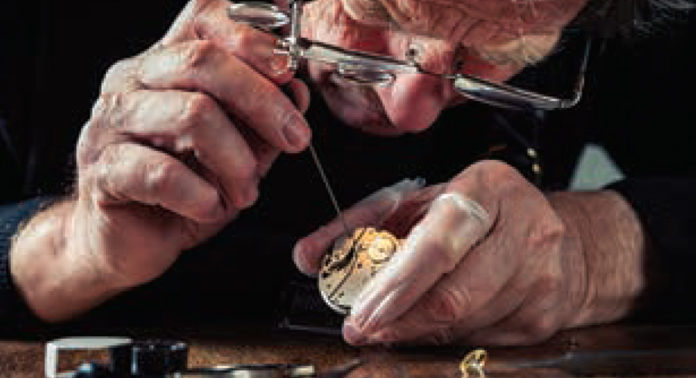
The Time for Quality Dentistry is Now.
Mechanical watches have always fascinated me. The precision, the craftsmanship, the innovation, and the artistry in fine timepieces are inspiring. In many ways, I based my approach to dentistry on the same principles behind many of the world’s finest watchmakers. Brands like Rolex®, Patek Philippe, Piguet, and Breguet, to name a few, are synonymous with an unrelenting commitment to creating the best products by using only the best materials.
I find an interesting correlation to dentistry in what was called the “Quartz Crisis” of the 1970s and early 1980s. This turbulent time in the watchmaking industry directly resulted from the invention and emergence of quartz movement. To keep time with very precise frequency, a quartz clock uses a small battery for power rather than an unwinding spring.
Quartz movement signaled a dramatic transition from mechanical watches to electronic timekeeping. Quartz watches began to replace the more traditional mechanical watches because they were cheaper and easier to make. Soon, these reasonably accurate watches flooded the market. They had all the functionality of a mechanical watch, but little of its original artistry. Many people said that the days of the mechanical watch were at an end and that no one would pay the prices required to produce the mechanical timepieces of the past.
In an online newsletter called Timepiece Chronicle, author Ben Newport-Foster writes that, “To say that the quartz crisis nearly destroyed the Swiss watch industry would be an understatement. It wasn’t a blip, it wasn’t a restructuring, it was a devastation.” However, the Swiss watch industry weathered the quartz movement. The mechanical timepieces, once thought to be going the way of the dinosaurs, are still available today.
Mechanical watches offer a direct counterpoint to cheaper quartz watches. How did the Swiss watch industry do it? Largely through innovation, artistry, and an uncompromising dedication to the best quality. Because of such focus, mechanical watches command higher prices than ever and continue to be in great demand.

In many ways, dentistry is currently facing a similar crisis. Today, we are practicing dentistry in an age of insurance-driven, “crowns-in-an-hour” corporate dentistry. The dental industry is becoming more of a commodity and a fee-for-service experience, and along with that there is a loss of artistry, craftsmanship, and quality that can’t be mass-produced. This dilemma raises the question, “Are the golden days of dentistry behind us?”
My response to that question is an emphatic “No!” Just as the naysayers back in the ‘70s and ‘80s were wrong about the demise of the mechanical watch, so too are those who say that the golden age of dentistry has passed. However, it’s true that dentists must innovate and push themselves past what has been the standard of care in the past.
If you are a dentist who does the basic, “what-the-insurance-covers” type of dentistry, you will likely see greater competition and diminishing returns. The secret to success for dentists in the coming years will be the same secret that saved the artisan watchmakers of the past—innovation and a dedication to quality.

In a like manner, today’s dentists must create a more dynamic practice, one that is not overly dependent on simply one aspect of dentistry. If you are a dentist who focuses on “basic” dentistry at the expense of large-case dentistry, implants, and other comprehensive approaches, then you are putting your practice at the mercy of insurance forces seeking to turn dentistry into a commodity experience.
The ability to do implants, large-case dentistry, appliance therapy, sleep dentistry, occlusion, and more can become a powerful means of differentiating your practice from others and escaping the forces that diminish your production potential. I have found that rarely does the ideal treatment for a patient encompass only one aspect of dentistry. The truly life-changing outcomes come about because the dentist draws upon various treatment modalities and brings them together in a seamless solution. The result is a patient whose life is dramatically improved and a dentist with higher levels of production and satisfaction.
Strive for More
As a dentist, I never arrived at a point in my career where I thought I knew it all and could stop learning. For me, the refinement of existing skills in conjunction with the attainment of new ones was the lifeblood of my practice. Constant improvement of one’s skills is the embodiment of “creating the best by using only the best.”
Your skill set is the primary “material” with which you will create positive outcomes for your patients. Advances in equipment and material sciences are certainly helpful, but they can never make up for a lack of skill.
The advent of quartz movement didn’t kill the mechanical watch as many had predicted. It did, however, require that such watchmakers innovate and establish a clear value proposition. To those who say that most patients aren’t willing to pay for expensive dentistry, I offer the following: the Swiss watchmaking industry only produces about 1.7 percent of the world’s timepieces, but it accounts for almost 58 percent of the value of the global market.
The reason for this is that they have invested in the skill, innovation, and commitment to excellence that is at the heart of creating value to the consumer. The same is true in dentistry. You don’t have to have all your patients say “yes” to treatment. But by having the skills and presenting the best treatment to all your patients, you create a practice that has a powerful value proposition that drives not only increased production, but also offers increased satisfaction.
Expand your skills and offer quality treatment that frees you from the forces of insurance-driven dentistry. Patients want and will find ways to pay for quality and innovation. It is the beginning of a new year and the ideal time to recommit yourself and your practice on the path of excellence.










The value created for the patient is remarkable it is true, but the satisfaction and peace one feels because he treats all people this way is in many ways unmatched. Good article.